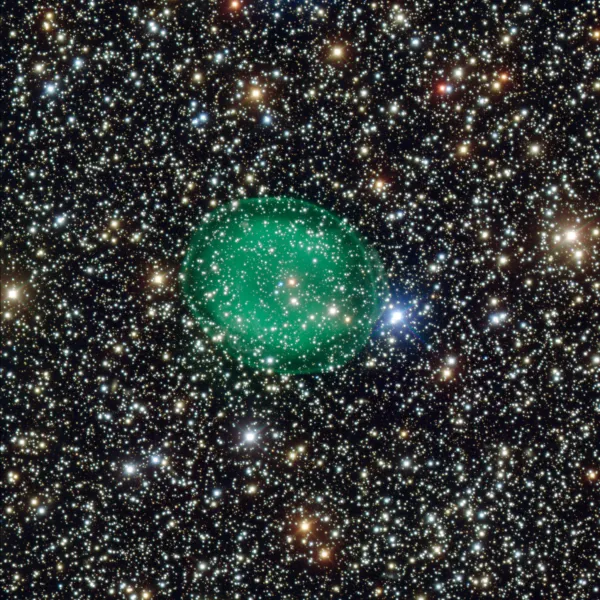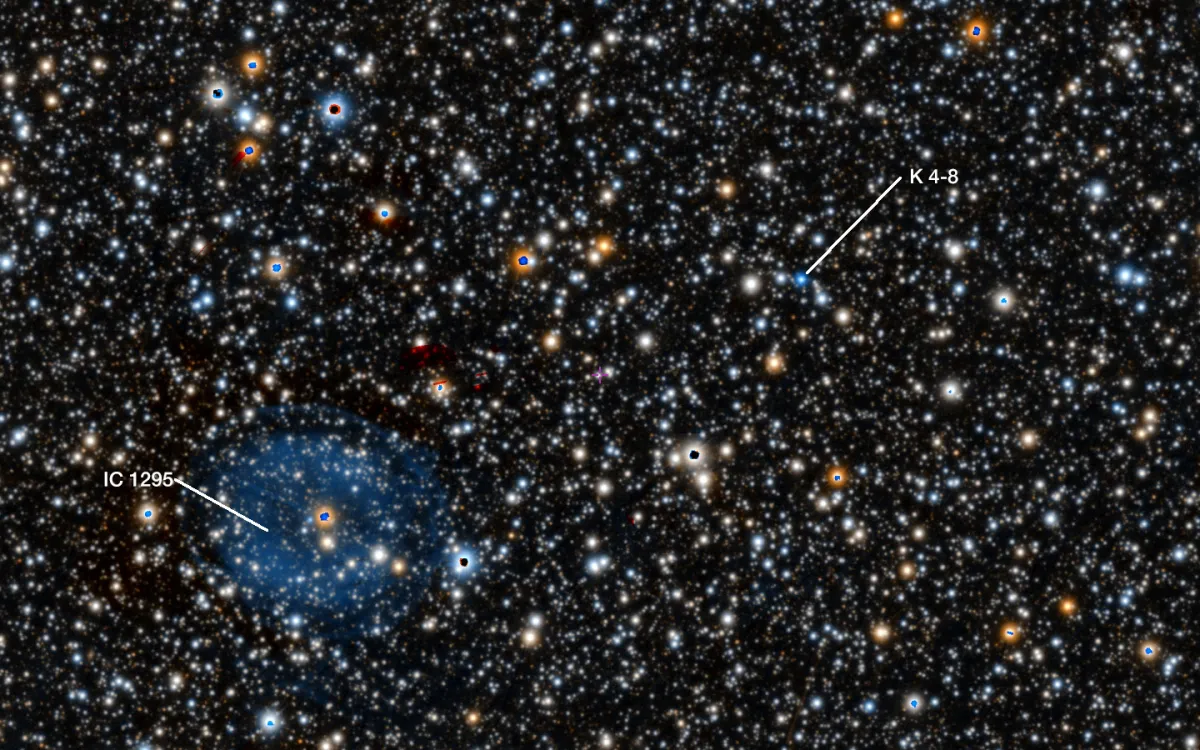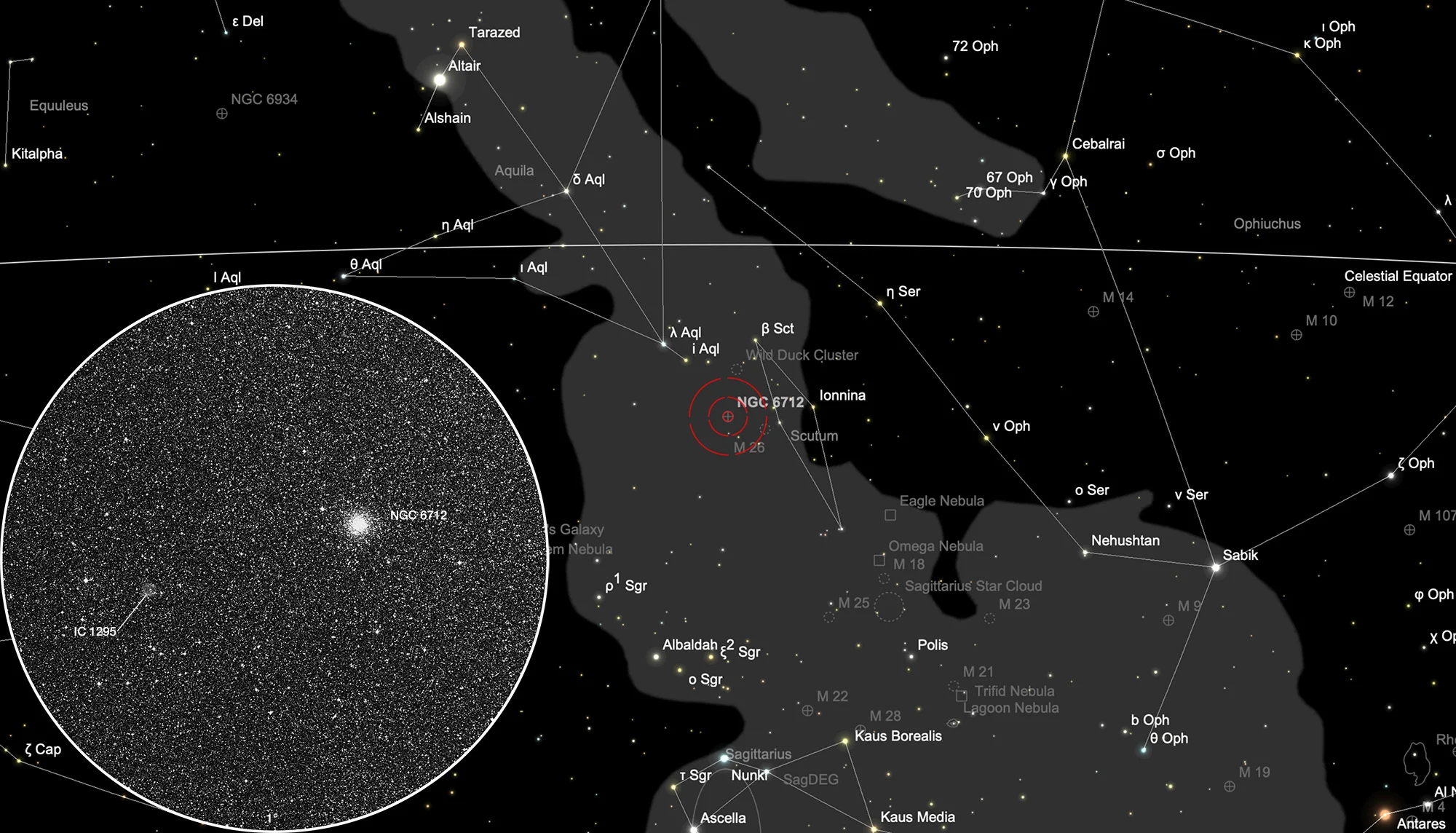Globular Cluster NGC 6712 & PNs IC 1295, Kohoutek 4-8

Globular Cluster NGC 6712
On 16 June 1784 the German-British astronomer William Herschel discovered an object that he thought was a «bright nebula» and cataloged it as I 47. He described it as «bright, very large, irregularly faint, easily resolvable stars visible» [463] Herschels son John cataloged the object in 1864 as GC 4441 (h 3762) and recognized it as a globular cluster. [467] John L. E. Dreyer added the globular cluster as NGC 6712 to his famous catalogue. [313]
NGC 6712 is a tidally disrupted globular cluster containing more then 60'000 stars. The reddening of the cluster due to interstellar matter is estimated as E(B − V) = 0.35 ± 0.04 from the RRab stars colour curves. The mean distance is 8.1 ± 0.2 kpc and the age is estimated to 12 billion years. [547]
| Designation | NGC 6712 |
| Type | GCL (IX) |
| Right Ascension (J2000.0) | 18h 53m 04.3s |
| Declination (J2000.0) | -08° 42' 20" |
| Diameter | 9.8 arcmin |
| Visual magnitude | 8.1 mag |
| Metric Distance | 6.900 kpc |
| Dreyer Description | globular, pB, vL, irr, vglbM, rrr |
| Identification, Remarks | WH I 47; h 3762; GC 4441; GCL 103 |

Planetary Nebula IC 1295
This nebula was discovered on 28 August 1867 by the American astronomer Truman Safford using the 18.5" refractor at the Dearborn Observatory in Chicago. He added it as number 82 to his list of discoveries which he published in 1887 as an appendix to the Dearborn Observatory Report for 1885 and 1886. Dreyer was unaware of these discoveries until he had finished preparation of his «New General Catalogue». He added his discoveries as an appendix with the description: «pretty bright, prettly large, gradually brighter in the middle.» [277, 313] In 1895 Dreyer added the nebula as IC 1295. [314]
In 1919 Heber Doust Curtis did a survey of nebulae at the Lick Observatory and identified IC 1295 as a planetary nebula. He described his discovery with: «Exceedingly faint; a faint, hazy ring about 2' x 1.5' in p. a. 90° ±. The central portions are relatively vacant, and it is fainter along and at the ends of the major axis. There are three faint stars at the centre, of which one is probably the central star.» [544]
| Designation | IC 1295 |
| Type | PN |
| Right Ascension (J2000.0) | 18h 54m 37.1s |
| Declination (J2000.0) | -08° 49' 35" |
| Diameter | 1.5 arcmin |
| Photographic (blue) magnitude | 15.0 mag |
| Visual magnitude | 12.5 mag |
| Metric Distance | 1.454 kpc |
| Dreyer Description | pB, pL, gbM |
| Identification, Remarks | PK 25-4.2; CS=15.0 |

Planetary Nebula Kohoutek 4-8
This small planetary nebula was discovered in 1964 by L. Kohoutek during the «Hamburg Schmidt-camera survey of faint planetary nebulae». [545] There seems to be no detailed study available for this probably young PN. It is so small, it looks like a blue star on photographs. Simbad lists the following magnitudes measured for different bands: J 14.792, H 14.802, K 13.946. [145]
| Designations | PN G025.3-04.6: K 4- 8, PK 25-04.1, Sa 2-374 |
| Right Ascension (J2000.0) | 18h 54m 20s |
| Declination (J2000.0) | -08° 53' 32" |
| Dimensions | 0." (optical) |
| Discoverer | KOHOUTEK 1964 |
Finder Chart
The globular cluster NGC 6712 and planetary nebula IC 1295 can be found in the constellation Scutum. On 5 July they are in opposition to the Sun and crosses the meridian at local midnight. They are best visible in the months March to December.
Visual Observation
300 mm Aperture: In the 21 mm Ethos (57x), the globular cluster NGC 6712 is visible as a pale, blurred patch, but cannot really be resolved into individual stars. Without an OIII filter, only the central star of the planetary nebula IC 1295 is visible. With a filter, the nebula is visible as a uniform, structureless disc. In the 13 mm Ethos (92x), IC 1295 is only visible with indirect vision without a filter. With an OIII filter, a slightly darker inner area can be discerned. In the 8 mm Ethos (150x), individual stars are visible in the globular cluster NGC 6712. With a filter, however, the PN appears rather too dark. I didn't even attempt to observe Kohoutek 4-8 due to the suboptimal observing conditions with light cirrus clouds. — 300 mm f/4 Popp-Newton, Hasliberg, SQM 20.9, 18. 10. 2025, Bernd Nies
762 mm Aperture: The globular cluster NGC 6712 appears nebulous and is barely resolvable. Its central region is slightly brighter, as would be expected from a globular cluster. In the planetary nebula IC 1295, the central region can be discerned as a faint, slightly darker hole. — 30" f/3.3 SlipStream Dobsonian, Hasliberg, 18. 10. 2025, SQM-L 21.02, Eduard von Bergen
